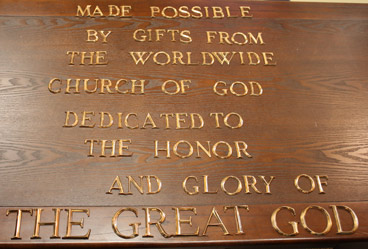PCG Added Another Relic
Gerald Flurry’s PCG added another relic to its collection:

Here is some of what PCG said about it:
EDMOND—In the most recent instance of the ruins of Herbert W. Armstrong’s legacy being raised, the Philadelphia Church of God has acquired the bronze letters from the Ambassador Auditorium’s dedication inscription…
After discovering the cost of casting all the letters needed for the dedication inscription of the PCG’s Armstrong Auditorium would have totaled around $10,000, church officials contacted Harvest Rock Church about the possibility of buying the letters. church officials contacted Harvest Rock Church about the possibility of buying the letters. They offered the letters to the PCG as a gift and suggested a $100 token of thanks. The PCG sent $250 to cover the shipping and a donation of thanks.
Receiving the letters from Ambassador was not only a significant blessing financially, but also in terms of incalculable sentimental value. Facilities manager and Ambassador College graduate Roger Brandon said, “In one sense [the letters] are worthless to someone else … I saw them and had to walk away. You get a bit emotional.” The only words that need to be newly cast are “Armstrong Auditorium” and “Philadelphia.”…
The letters will take up their new home in the Grand Lobby on the center onyx wall between the two candelabra, just as they did in Ambassador under Mr. Armstrong, dedicating the building to God. In addition to the candelabra, the letters join the Swans in Flight sculpture by Sir David Wynne and a 9-foot Steinway concert grand piano from Ambassador Auditorium as a group of treasures the PCG has acquired from the former Worldwide Church of God campuses. The mission of the PCG via its Armstrong International Cultural Foundation is to revive and continue the cultural and humanitarian legacy of Herbert W. Armstrong. http://www.pcog.org/article.php?articleid=97 (photo from same source)
While some in PCG will argue that this was mainly done as a cost-saving measure, the above “press release” suggests that it is more than that.
Here is an astute assessment by Shadows of WCG webmaster “J”:
I have written many times about the idolatry of the physical attributes of the Ambassador Auditorium that permeates with sickening nausea from so many. From the pianos to the candelabra to these bronze letters – directly to the bronze swan fountain, one would think they would get a clue over getting emotional and having to walk away over bronze lettering would show that something is very, very wrong with that picture.
It is, in my opinion, the strongest form of blatant idolatry.
The Philadelphia Church of God seems to be on a mission of “raising the ruins” – physical ruins – of what is left of the Worldwide Church of God’s physical programs and assets.
While doing so, they store up treasures on Earth – and abandon “treasures in heaven”.
PCG has for a long time, focused (in my opinion) on mainly how to physically appear to be like the old WCG.
Relic acquisition among the Greco-Roman churches began in earnest in the fourth century. Notice the following:
It appears that Helena was converted to Christianity when she was 63 years of age. As though to compensate for the years before her conversion, she set out in the year 324 with great zeal and fervor to build churches, to restore and adorn older ones and to find precious relics…She was elevated by her son to the position of empress of the world and mistress of the empire (Cruz JC. Relics. Our Sunday Visitor Publishing, 1984, p. 255).
…thanks to Emperor Constantine…his mother Saint Helena began a campaign to recover as many relics of Christianity as she could get her hands on (John Trigilio, Kenneth Brighenti. The Catholicism Answer Book: The 300 Most Frequently Asked Questions. Sourcebooks, Inc., 2007, p. 258).
Emperor Constantine I, appointed his mother Helen as Augusta, and gave her unlimited access to the imperial treasury in order to locate the relics of Judeo-Christian tradition. (Helena of Constantinople. Wikipedia, viewed 04/20/09)
It was mainly because of Constantine and Helena that the Greco-Roman churches adopted idols and icons for their churches. The Bible itself warns that even using genuine relics can be a problem (2 Kings 18:4).
And while I do not believe that those in PCG will directly worship the bronze letters or other relics that have been acquired, I do believe that they will feel that their ownership proves (to many of them at least) that PCG is the correct church.
While I have nothing against attaining the letters per se, this announcement from PCG (combined with its earlier acquisitions) really does remind me of Emperor Constantine’s mother’s quest for relics and pictures in the fourth century.
Of course, until the fourth century, relics were avoided by most who professed Christ. And while buying the bronze letters of itself does not prove idolatry, the pattern of PCG acquiring relics certainly suggests that its focus may be a bit too much on outward appearance and perhaps worse.
Two articles of possibly related interest may include the following:
Teachings Unique to the Philadelphia Church of God Simply calling oneself ‘Philadelphia’ does not make one so (see Revelation 3:7-9), nor does Gerald Flurry calling himself “that prophet” make it so. This article provides many quotes from this group which claims to be faithful.
What Did the Early Church Teach About Idols and Icons? Did Catholic and Orthodox “saints” endorse or condemn idols and icons for Christians?
 |
Tweet |
|